Table of Contents
|
Pure Water and Healthy
Children
The
new arena was but one of
many highly visible structures that marked
Richmond Hill's
transformation from a sleepy late-nineteenth-century village to a bustling
twentieth-century community during the decade of the 1920s. But that
transformation was also brought about by changes in the less visible
infrastructure.
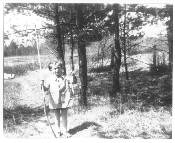 |
| Young
Alex Carson
displays his day's catch of fish from the
Mill Pond. |
In 1921, for example,
village council built a dam and pump house at the south end of the
Mill Pond on
Mill Street to supply a
municipal waterworks system.
The water was drawn from the pond through filter beds, stored in a
water tower on
Trench Street with a
capacity of 60,000 gallons (about 230,000 litres), and distributed by pipe to
community residents and business establishments.
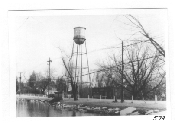 |
| Water tower at the
Mill Pond, built in
1921 and demolished in April 1962. |
The
water tower may have been
impressive, but its contents were no taste treat. During her first visits to
Richmond Hill in the
early 1920s, community historian
Mary Dawson
remembered complaining "bitterly of the weedy, brackish taste of the water."
Since the south end of the
Mill Pond became covered
"with a thick coating of revolting looking green scum" during the hottest days
of summer, such complaints were no doubt justified.
4
Acting on such
complaints and regularly inspecting the water supply were the responsibility of
the local Board of Health and its medical officer of health,
Dr. J.P. Wilson. In
mid-August of 1924, for example,
Dr. Wilson warned
Richmond Hill
residents that village water was unsafe for domestic use without first being
boiled. A week later, he reported the water much improved, but it still
required boiling.
5
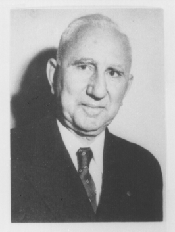 |
| Dr. John P.
Wilson (1886-1965). Born in Albion Township and a graduate of the
University of Toronto medical School,
Dr. Wilson set
up practice in
Richmond Hill in
the fall of 1918, during the bad influenza epidemic. He and
Dr. Rolph
Langstaff took yearly turns as medical officer of health for
Richmond Hill
during the 1920s.
Wilson served
three years on village council in the 1940s, and was active in community
affairs even after his formal retirement from medicine in 1962. |
By 1927, council decided to move the intake to the north
end of the
Mill Pond, where the
water was judged to be purer, cleaner, and better-tasting. Not all north-end
property owners applauded this change - one fought expropriation of land and
another sued the village for flood damage allegedly caused by the new dam. But
work proceeded through the summer of 1928 and the northern intake was hooked
up.
With a supply of healthier and better-tasting
municipal water established, the Board of Health could address other concerns.
During 1927, for example, it enforced quarantine regulations, supervised
vaccination programs in schools, sent samples of milk for testing in provincial
laboratories, and appointed a veterinarian to inspect local dairy herds. The
medical health officer,
Dr. Wilson, also
dealt with less glamorous matters: complaints about septic tank overflows,
water lying in ditches, dead animals on vacant lots, manure piles, water in
cellars, and in one case, even "odors from a neighbour's wash water."
6
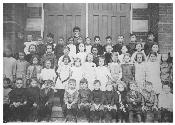 |
| Mary Lillian McConaghy and her class, pictured on the
front steps of the
Richmond
Hill Public School in 1915. Front row, left to right:
- Innes,Laverne
Wright, -, -,
Doc Atkinson,Lewis Sims,Art Leach,Bill Innes,Jim Grainger,Alfred
Grainger,- Burns,- Warren Second row: -,
-,
Bertha Hopper,Alice Innes,- Stong,- Tindall, -, -, -, -,
- Battie,- Smith,Audrey Tuck Third
row:
- Smith,- Battie,Ida Blanchard,Isobel Wilson,- Raymer,Betty
Hewetson,- Smith Back row: -, -,
Peter
Savage, -,
- Flanigan;
Donald Wren, -,
-, -, -,
Ted Bennett,Bert
Grainge |
Children's
health remained the most visible public concern through the 1920s. Of the 1316
Richmond Hill,Markham Township,
and Markham Village school children inspected by a nurse-doctor team in 1929,
only 35 were found to be without apparent physical defects. Poor teeth topped
the list of deficiencies, followed by abnormal tonsils, defective nasal
breathing, malnutrition, defective vision, and defective hearing.
7 With such results before them,
Richmond Hill
residents voted by plebiscite for a public health nursing program, which
allowed nurses to make regular physical examinations of children at
Richmond Hill
Public School. No doubt similar concerns prompted the school board to
replace the old outdoor toilets with chemical ones about 1928.
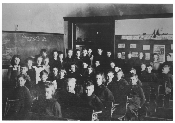 |
| Room 4,
Richmond
Hill Public School, in 1922. Pupils sit upright in double desks, hands
behind their backs, ready for the serious task of learning. |
But learning and discipline remained the
major responsibilities of the
public
school during the decade of the 1920s. Before school and at recess, boys
and girls played in separate parts of the school yard, kept apart by a board
fence. The end of their temporary freedom was announced when Principal
Walter Scott rang a
handbell and the boys and girls had to line up at their separate doors. As the
children marched into the halls, teacher
Mrs. McConaghy played "An English Country Garden" on the
piano, while "on days when he felt exuberant, Mr. Scott would keep time with
his softly tinkling hand bell."
8
Inside the classrooms, learning was serious business
and discipline was quite harsh. Even the extracurricular activities were
challenging -
Mr. Scott's mental
arithmetic contests at noon hour; an annual public speaking contest sponsored
by the
Women's
Institute; garden plots, where pupils planted seeds in the spring and
displayed their produce and flower arrangements in the fall.
In the end, most graduates of
Richmond Hill
Public School probably reserved their fondest memories for
Mrs. McConaghy. A daughter of
Dr.
James and
Mary Ann
Langstaff and a great-granddaughter of
Abner and
Mercy Miles,Mary Lillian McConaghy taught at the
school
for forty years. She remained a revered community figure long after she
retired, and - like her brother
Rolph - lived to
celebrate her one-hundredth birthday. Today, the building in which she taught
for four decades serves the community's senior citizens and celebrates her name
as the
M.L. McConaghy
Centre.
Youngsters who passed through
Mrs. McConaghy's hands during the 1920s, completed eight
grades at the
public
school, and passed the provincially administered Entrance Examination
moved on to
Richmond Hill
High School, where they were joined by pupils coming into town from
elementary schools throughout much of
York County. Teenagers
from both town and country then settled into a provincially determined program
that was even more highly regimented and tightly controlled than elementary
school curriculum. Many dropped out after a year or two of
high
school and joined the labour force; others diligently worked their way
through four or five years to Junior or Senior Matriculation.
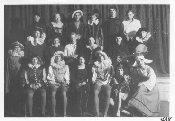 |
| Cast for a production of
Shakespeare's "Twelfth Night,"
Richmond
Hill High School, 1925. |
Secondary school enrolment rose noticeably during the
early 1920s once tuition fees were abolished and more stringent provincial
attendance regulations were enforced. The old
 |
| Young athletes at
Richmond
Hill High School in the 1920s. |
Richmond Hill
High School at the southwest corner of Yonge and
Wright streets became
too small, and was replaced by a new building farther west, on the north side
of
Wright Street. This
new two-storey, $100,000 building housed eight classrooms, plus a basement
gymnasium, library, and office, and it was surrounded by a large playing field.
9 The structure survives today as the centre
section of the expanded
Richmond Hill
High School, while the older 1897 edifice eventually became the
Municipal
Building.
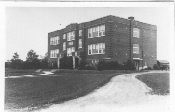 |
| The new
Richmond
Hill High School of 1924, the core of the current
high
school building on
Wright
Street. |
The new building, which was opened on December 5, 1924,
confirmed the village's strategic role in secondary education along
Yonge Street. Half a
century earlier,
Richmond Hill had
boasted the only high school between Toronto and
Newmarket; in the early
1920s it could still claim the only secondary institution between Toronto and
Aurora. So students had long
come into town from south and north and from east and west to attend classes.
Figures for 1922, for example, showed that only 18 per cent of the pupils were
from the village itself, while 82 per cent came in from the surrounding area.
10 Some of the rural pupils boarded in
town; others came by radial car or bus or bicycle. Two young men in the
mid-1920s rode in on horses from
Headford.
 |
| The
Loyal
True Blue and Orange Home,Yonge Street
North, opened in 1923. Roger Carlsen |
Hundreds of county children who had been placed in
temporary care away from their families, lived and went to school at the
Orange
Home on
Yonge Street north of
the village. The institution opened in 1923 under the sponsorship of the
Orange Lodge, which
gave the place the lofty moniker of the
"Loyal
True Blue and Orange Home." Its stated purpose was to give children a
Christian upbringing, "approaching as nearly as possible that received in a
normal family home."
Many
Richmond Hill
residents gathered in front of
the
Home at 4:00 p.m. on July 2, 1923, to watch the first children arrive.
The large building contained dormitory rooms, a chapel, an infirmary, dining
hall, lounges, and three classrooms. By 1925, the home housed 148 youngsters,
all under the firm control of a matron, assistant matron, two teachers, boys'
supervisor, girls' supervisor, and support staff.
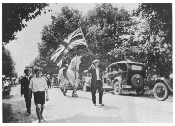 |
| A 12th of July
Orange Parade in
Richmond Hill,
featuring the Union Jack and "King Billy" on his white horse. |
Despite its internal school arrangements and largely
self-contained world,
the
Home became a part of the
Richmond Hill
community. Children came into the village to attend church each Sunday, and
donations to the
Orange
Home made by local residents were noted in the columns of
The Liberal. It was quite appropriate that,
scarcely a month after
the
Home's opening in 1923, two of its residents were chosen to lead the
parade that launched
Richmond Hill's
fiftieth anniversary of incorporation and the
Grand
Re-Union of Old Boys and Girls.
Notes
4.
Mary Dawson,"Waterworks System Brought
Complaints,"The Liberal,March 7, 1979.
5.
Mary Dawson,"Flashback: In Years Gone By,"The Liberal,September 7,
1967.
6.
Mary Dawson,"Yesterdays,"The Liberal,May 16, 1979.
7.
Mary Dawson,"Shocking Figures Led to First Health
Service,"The Liberal,March 28, 1979.
8.
Peter N. Ross,"Education in Richmond Hill,
1811-1961," Local History Collection, Richmond Hill Public
Library.
9.
Ibid.
10.
The Liberal,December 7, 1922.
Previous
Next
Copyright © Richmond Hill Public Library Board, 1991
|

